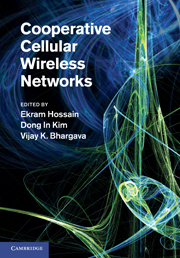Book contents
- Frontmatter
- Contents
- List of contributors
- Preface
- Part I Introduction
- 1 Network architectures and research issues in cooperative cellular wireless networks
- 2 Cooperative communications in OFDM and MIMO cellular relay networks: issues and approaches
- Part II Cooperative base station techniques
- Part III Relay-based cooperative cellular wireless networks
- Part IV Game theoretic models for cooperative cellular wireless networks
- Part V Standardization activities
- Index
2 - Cooperative communications in OFDM and MIMO cellular relay networks: issues and approaches
from Part I - Introduction
Published online by Cambridge University Press: 03 May 2011
- Frontmatter
- Contents
- List of contributors
- Preface
- Part I Introduction
- 1 Network architectures and research issues in cooperative cellular wireless networks
- 2 Cooperative communications in OFDM and MIMO cellular relay networks: issues and approaches
- Part II Cooperative base station techniques
- Part III Relay-based cooperative cellular wireless networks
- Part IV Game theoretic models for cooperative cellular wireless networks
- Part V Standardization activities
- Index
Summary
Introduction
The continually increasing number of users and the rise of resource-demanding services require a higher link data rate than the one that can be achieved in current wireless networks. Wireless cellular networks, in particular, have to be designed and deployed with unavoidable constraints on the limited radio resources such as bandwidth and transmit power. As the number of new users increases, finding a solution to meet the rising demand for high data rate services with the available resources has became a challenging research problem. The primary objective of such research is to find solutions that can improve the capacity and utilization of the radio resources available to the service providers. While in traditional infrastructure networks the upper limit of the source destination (S–D) link's data capacity is determined by the Shannon capacity, advances in radio transceiver techniques such as multiple-input multiple-output (MIMO) architectures and cooperative or relay-assisted communications have led an enhancement in the capacity of contemporary systems.
In the MIMO technique the diversity relies on uncorrelated channels, and is achieved by employing multiple antennas at the receiver side, the transmitter side, or both, and by sufficiently separating the multiple antennas (of same polarization). The MIMO technique can be used to increase the robustness of a link as well as the link's throughput. Unfortunately, the implementation of multiple antennas in most modern mobile devices may be challenging due to their small sizes.
- Type
- Chapter
- Information
- Cooperative Cellular Wireless Networks , pp. 13 - 44Publisher: Cambridge University PressPrint publication year: 2011
- 4
- Cited by



